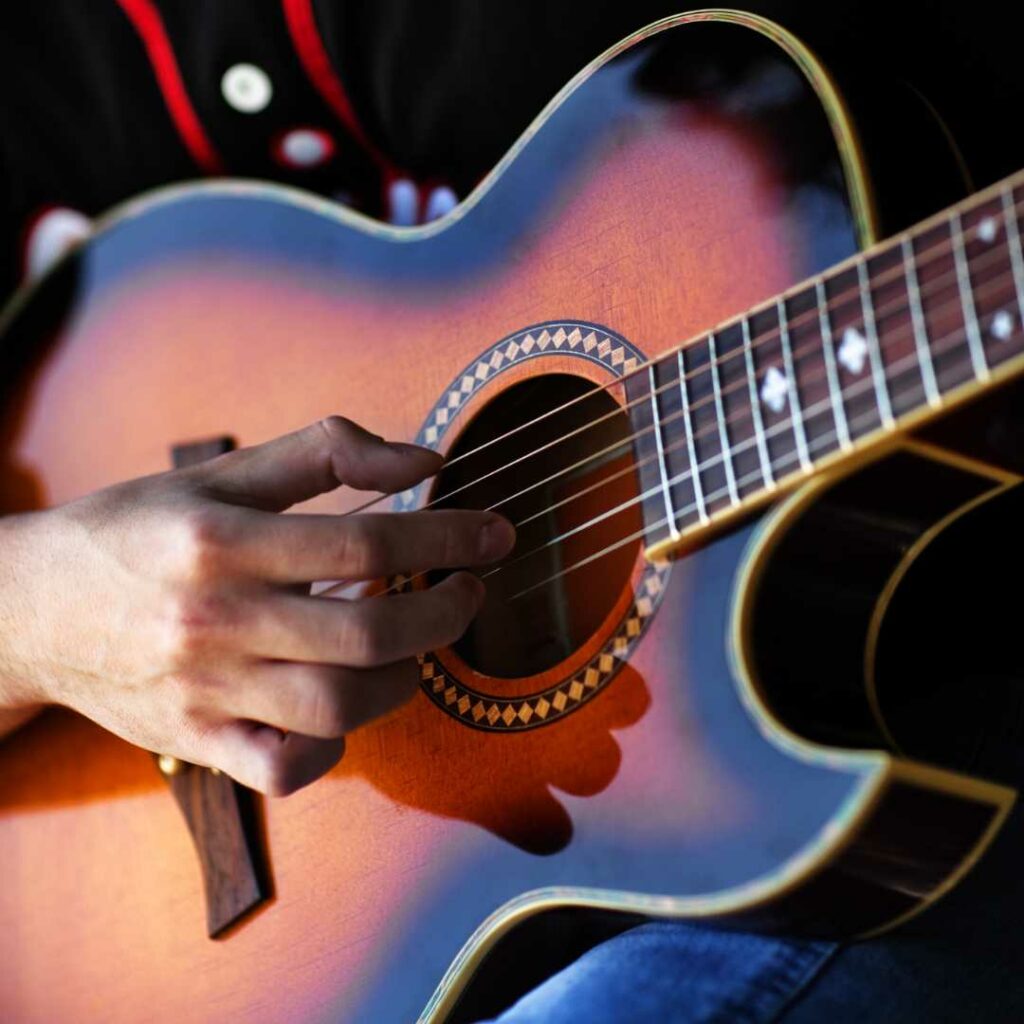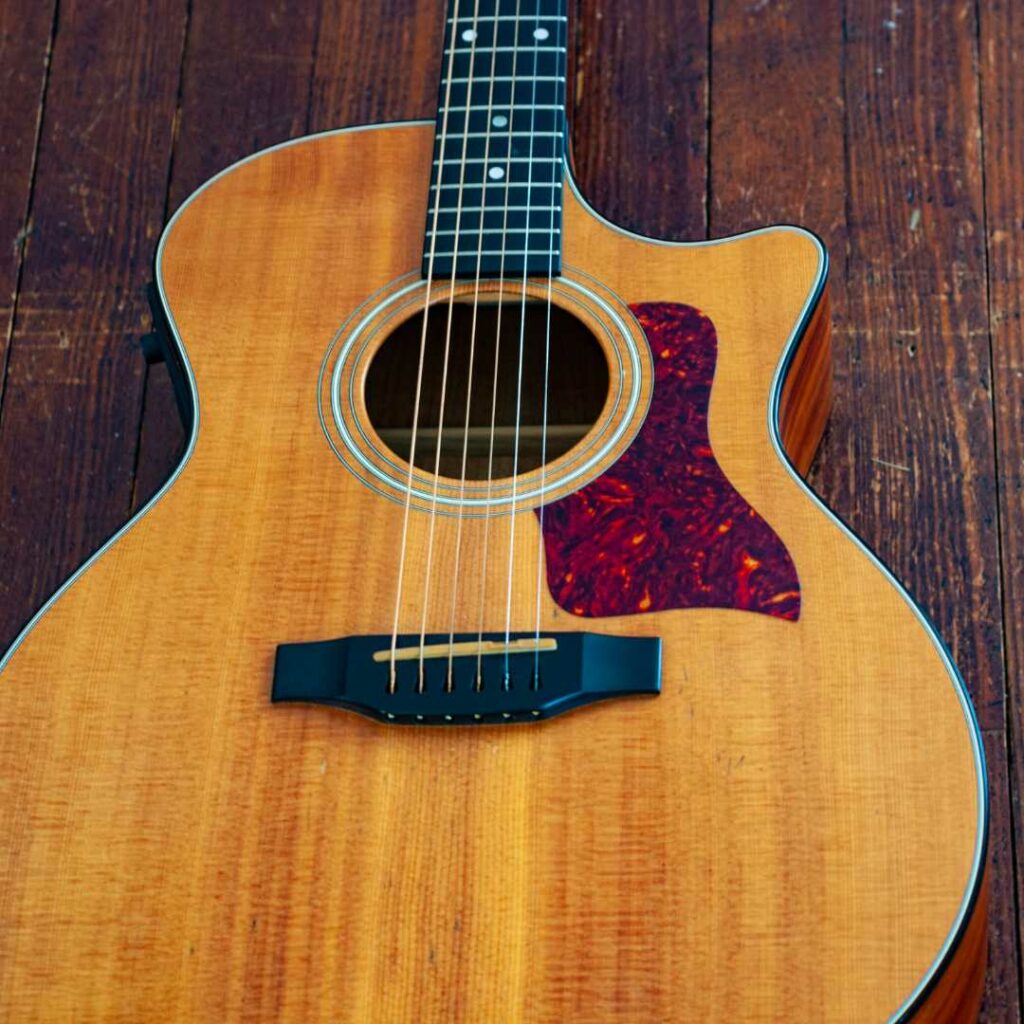Choosing the right acoustic guitar is essential to your craft as a songwriter or musician who primarily uses a guitar to write. You might wonder whether a guitar with a cutaway or non-cutaway design is right for you.
As an experienced guitarist with over 25 years of playing and songwriting experience, let me guide you through this decision-making process for one factor of finding your perfect guitar.
This article will explore the key differences between cutaway and non-cutaway guitars and help you decide which will suit your playing style better.
Table of Contents
Cutaway vs. Non-Cutaway | The Short Answer
Cutaway guitars are designed with a curve in the upper part of the body, right below the neck. This allows for easier access to higher frets. A cutaway guitar might be a better fit if you’re a beginner who wants to explore various styles, such as rock, jazz, folk rock, and blues.
Non-cutaway guitars, on the other hand, feature a more traditional design without the curve. Some may argue that a cutaway guitar has less bass response than a non-cutaway, but this difference is extremely minimal, if a factor at all.
When deciding, consider how crucial upper fret access and various playing styles are to you versus the classic look a non-cutaway guitar offers.
Remember that personal preference plays a huge role, so the best course of action is to try out both types of guitars for yourself and see which one resonates with you the most.
What is a Cutaway Guitar?
A cutaway guitar is a design feature on many acoustic and electric guitars, characterized by a treble-side indentation in the upper bout.
The primary purpose of a cutaway is to offer more accessible access to higher frets, enabling more comfortable playing and an expanded range for solos and intricate finger work.
Venetian vs. Florentine Cutaway
There are two main types of cutaways: Venetian and Florentine. The Venetian cutaway has a rounded, smooth curve, whereas the Florentine cutaway features a sharper, pointed design.
The choice between these options mostly comes down to aesthetics and personal preference, as both serve the same functional purpose of providing better access to higher frets.


Impact on Sound
It’s worth noting that the presence of a cutaway may impact the guitar’s tone. With a cutaway, the guitar produces a slightly brighter sound with less body. This effect is due to a slightly reduced resonance chamber, which can also lead to a subtle decrease in volume compared to non-cutaway guitars.
With this said, the difference is negligible, and in a blind test, you’d have difficulty telling the difference.
Pros & Cons of a Cutaway Guitar
When considering a cutaway guitar, it’s essential to weigh the advantages and disadvantages:
Pros
- Easier access to higher frets
- Expanded range for solos
- Often considered more visually appealing
Cons
- Slightly altered tone (more treble-heavy)
- Potential reduction in volume
- May not be preferred by players seeking a more traditional look
Is a Cutaway Acoustic Guitar Right For You?
Deciding between a cutaway and non-cutaway guitar ultimately comes down to individual preferences and playstyles.
Suppose you frequently venture into higher frets for solos or intricate fingerwork and want a more modern-looking performance guitar. In that case, a cutaway guitar might be the right choice for you.
Great Cutaway Acoustic Guitar Choices by Budget & Brand
If you’re considering a cutaway acoustic guitar, here are some excellent options across various price points and reputable brands:
- Budget-friendly: Yamaha, Fender, Guild, & Alvarez
- Mid-range: Taylor, Martin, & Breedlove
- High-end: Taylor & Martin
What is a Non-Cutaway Guitar?
A non-cutaway guitar is an acoustic guitar with a continuous body shape without the indentation or “cut” found in cutaway guitars. Due to their complete bout design, these guitars maintain a traditional appearance and offer a fuller sound.
The Aesthetic Pull of A Non-Cutaway Guitar
For many guitar players, their design is one of the greatest appeals of non-cutaway guitars.
These musical instruments” symmetry and classic look create a specific visual harmony that some players find more aesthetically pleasing. Consequently, it’s not just about how it sounds or plays; it’s also about how it looks and feels in your hands.
I believe that the visual appeal of a non-cutaway does inspire guitar players to pick up the instrument and create music, as silly as it sounds.
Sound
Non-cutaway guitars can produce a fuller sound with better bass and volume than their cutaway counterparts. The thought process is that the complete body shape allows for a larger resonating chamber, contributing to a richer and more balanced tone.
While this might be true to an extent, as stated earlier, you may have trouble hearing the difference in a blind test.
Non-Cutaway Guitar: Pros & Cons
Before you decide on a non-cutaway guitar, it’s essential to consider the advantages and disadvantages. Here are some of the pros and cons:
Pros:
- Visually appealing with a classic, timeless design
- Some players report there is better volume and projection
Cons:
- Limited access to higher frets
- May not be as comfortable to play for some musicians
Is a Non-Cutaway Acoustic Guitar Right For You?
As is the overarching theme of this article, choosing the right guitar ultimately comes down to personal preference and playing style.
If you value a fuller sound and a classic design and refrain from frequently venturing into the upper register or playing high notes yourself, a non-cutaway guitar might be an excellent choice.
However, a cutaway guitar might be a better fit if you play lead guitar or often use the upper frets.
Great Non-Cutaway Guitar Choices by Budget & Brand
If you’re considering a non-cutaway guitar, here are some excellent options across various price points and reputable brands:
- Budget-friendly: Yamaha, Fender, Guild, & Alvarez
- Mid-range: Taylor, Martin, & Guild
- High-end: Taylor, Martin, & Gibson
These guitars offer a rich, classic, timeless design. Whether you’re a beginner or a seasoned pro, there’s a non-cutaway guitar out there that’s perfect for you.
Playing Style, Goals, & Budget
Consider your playing style and preferences when choosing between a cutaway and a non-cutaway guitar. If you often play solos and need to reach higher frets, a cutaway guitar may be the best choice for you. However, a non-cutaway might be the best choice if you primarily play rhythm or chords.
Non-cutaway guitars tend to be less expensive than cutaway guitars. If budget is a primary concern, you should consider a non-cutaway.
Consider your skill level, comfort with higher frets, and your budget and personal taste in guitars.
Acoustic-Electric
Another factor to consider is whether you want an acoustic-electric guitar, which can work well with cutaway and non-cutaway designs. Acoustic-electric guitars have built-in pickups and preamps, allowing you to amplify your sound and perform live efficiently.
Electronics in budget-friendly guitars may come at the cost of the overall quality of the guitar. Often, you will get a better acoustic guitar (solid woods and quality assurance) when you purchase budget guitars ($400-$750) that don’t come with electronics.
Body Size & Scale Length
Guitars’ different body shapes and sizes can influence the guitar’s sound, playability, and comfort. Larger body shapes like dreadnoughts or jumbos tend to have more bass, volume, and a fuller sound. On the other hand, smaller shapes like concerts, parlors, or grand auditoriums provide more focused sounds with a lighter touch.
Besides body shape, scale length can also affect a guitar’s playability and overall feel. A shorter scale length guitar means the strings have lower tension, resulting in more effortless playability. A longer scale length provides more string tension, requiring more effort to fret notes. This extra tension is valuable to guitar players who want to play in dropped tunings.
Both cutaways and non-cutaways can be found with various body shapes and scale lengths, so take the time to test and compare different options to find the most comfortable guitar for you.
Brand
Finding a reputable and reliable brand is crucial when searching for your perfect guitar. While many brands offer a variety of models and options, quality control and customer support are essential factors to consider.
Some well-known guitar brands like Taylor and Martin are renowned for their consistency and commitment to quality. This is an important consideration, as many must purchase online before touching the instrument.
Numerous lesser-known brands offer great value for their price, like Breedlove, Guild, and Alvarez. If you can get into a guitar shop and try out different guitars, this will be the best way to know what kind of guitar suits your playing style and budget.
It’s also important to note that some brands specialize in certain types of guitars, such as classical or flamenco guitars. If you have a specific style of music in mind, it may be worth researching brands that specialize in that style.
Do your research, read reviews, be bold, and ask other musicians or guitar experts for recommendations. With the right brand and guitar, you’ll be inspired to continue writing, recording, and improving your music.
Frequently Asked Questions
What Is The Difference Between a Dreadnought and Cutaway Guitar?
A dreadnought is a type of guitar body shape with a larger-sized, full-body construction, producing a louder and richer tone, especially in the bass frequencies. On the other hand, a cutaway guitar has a portion of the body “cut away” near the neck joint, allowing easier access to higher frets.
While a dreadnought can have a cutaway, not all cutaways are dreadnoughts. It’s important to consider which body shape best suits your playing style and needs.
Solid Wood or Laminate Wood for Topwood?
When it comes to topwood, solid wood guitars are known to produce a richer and more resonant tone compared to laminate wood top guitars.
Solid wood tops also tend to age better, with the wood “opening up” and improving in tonality over time. While solid wood guitars are generally more expensive, they are a worthwhile investment for serious musicians.
I recommend only purchasing acoustic guitars that come with a solid topwood. This will ensure the best possible sound quality and give you a guitar you can grow into.
Solid Wood vs. Laminate Wood for Back & Sides?
Similarly to topwood, solid wood back and sides produce better resonance and tonal quality than laminate wood. However, the difference is less pronounced than topwood, as the back and sides mainly contribute to the guitar’s overall projection, sustain, and tonal influence over the topwood.
If you’re on a budget or a beginner, laminate wood back and sides can be a more affordable option while still offering decent sound quality. As you progress in your guitar-playing journey, you may later invest in a guitar with solid wood back and sides for an improved tonal experience.
It’s worth noting that laminate wood will be less susceptible to warping and cracking from humidity. This makes laminated back and sides guitar an excellent option for a travel guitar and those who gig out often.
The Bottom Line
Whether you’re a beginner or a seasoned guitarist, choosing the right type of guitar is essential to your craft.
While cutaway and non-cutaway guitars have unique advantages, the decision ultimately comes down to personal preference and your playing style. By understanding the key differences between the two designs, you can make an informed decision that will help you achieve your musical goals.
So go ahead and try out both types of guitars to see which one feels right for you – the perfect guitar is out there waiting for you to discover it!
Thanks for reading!

